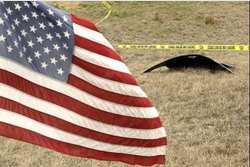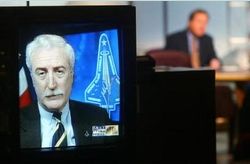By ANN Correspondents Pete Combs and Rob Milford
A piece of wing. A charred helmet. A shuttle mission
patch.
 These are among the thousands of pieces of debris
from the doomed shuttle Columbia that rained down on East Texas
Saturday.
These are among the thousands of pieces of debris
from the doomed shuttle Columbia that rained down on East Texas
Saturday.
Recovery workers, still stunned by the scope and proximity of
the disaster, continue to search the backroads and piney-woods of
East Texas, looking for enough debris to perhaps determine why
Columbia fell out of the sky upon re-entry.
A Charred Electronics Component.
A Piece Of Pipe.
A Homecoming That Never Was...
One recovery worker described it as "trying to find a million
needles in a haystack that's five thousand square miles wide." The
firefighters, rescue workers and the increasing number of National
Guard troops are stone-somber as they go about their grim task,
first marking off areas where shuttle debris litters the landscape,
then waiting for someone with FEMA or NASA to come by, catalog and
photograph the wreckage and, eventually, haul it off. Debris is
being taken to Barksdale AFB (LA), where it's being carefully
inventoried and investigated. Meanwhile, in Houston, hundreds of
mourners gathered at the Clear Lake Baptist Church, near the
Johnson Space Center, for an evening memorial service. A welcoming
ceremony (poster below) for the astronauts, scheduled for Houston
Sunday, wasn't even cancelled. It simply didn't take place.
"No Stone Unturned"

NASA Administrator Sean O'Keefe promised Sunday to leave "no
stone unturned" in the search for a cause to this second shuttle
tragedy.
"We're leaving nothing to chance. We're looking at every piece
of evidence, we're securing all the debris and assuring we look at
every possible angle of what could have caused this horrible
accident," he said on CBS' Face The Nation broadcast.
F-15 and F-16 warplanes are cruising over the huge debris field
at loiter speeds of approximately 250 KTS, helping spot debris on
the ground. NASA astronauts from the Johnson Space Center in
Houston arrived in Nacogdoches at around 1:00 PM CST Saturday to
lead the investigation. Troops and helicopters have been sent from
Carswell JRB in Fort Worth to help comb the area. The
investigation, NASA said, could take months.
Human Remains Among The Debris
 Searchers have found human remains along a 60-mile
swath of the debris field, from Nacogdoches, through San Augustine
to Hemphill. Among the remains found so far, a torso, a heart, a
skull and fingers, one of which was wearing a ring. A make-shift
morgue has been set up at an elementary school in Hemphill, where
the remains are being gathered and turned over to agents from the
FBI.
Searchers have found human remains along a 60-mile
swath of the debris field, from Nacogdoches, through San Augustine
to Hemphill. Among the remains found so far, a torso, a heart, a
skull and fingers, one of which was wearing a ring. A make-shift
morgue has been set up at an elementary school in Hemphill, where
the remains are being gathered and turned over to agents from the
FBI.
The Coast Guard will reportedly send a boat with sophisticated
underwater scanning gear and divers to a large revervoir near
Hemphill. Witnesses say a huge piece of the shuttle -- as big as a
compact car -- fell into that lake after Columbia disintegrated in
flight Saturday. Search crews speculated it could be part of the
crew cabin or part of the Shuttle Habitat, a bus-sized
environmental enclosure housed in the cargo bay, used as
headquarters for the many different science missions conducted
during STS-107.
"We will have divers in the water if necessary," said Billy
Smith, the local emergency manager.
A Parallel Search: Why?
 It's early in the investigation. NASA Chief Flight
Controller Ron Dittemore said Saturday the space agency would be
very quiet for the next few days, pausing to mourn and reflect on
the loss of the Columbia and its crew. Then would begin the process
of assessing what happened and making sure it never, never happens
again.
It's early in the investigation. NASA Chief Flight
Controller Ron Dittemore said Saturday the space agency would be
very quiet for the next few days, pausing to mourn and reflect on
the loss of the Columbia and its crew. Then would begin the process
of assessing what happened and making sure it never, never happens
again.
Already, attention is focused on the space plane's left wing. It
was there a piece of styrofoam insulation smacked into the shuttle
just over a minute after lift-off January 16th. On Friday, NASA
officials ruled the impact was of no significance to the safety of
the shuttle, allowing plans for a normal return to continue
uninterrupted. But in the moments just before Columbia broke up,
200,000 feet above East Texas, as temperatures on the heat shield
tiles rose above 3000 degrees Farenheit, heat sensors on the left
wing began to fail. The failure quickly spread inboard as more
temperature sensors failed and tire pressure sensors in the
shuttle's left landing gear went offline.
"As we look at that now in hindsight, we can't discount that
there might be a connection," said Dittemore.
Heat Tiles Litter The Landscape
 Back in Texas, the debris field looks, at first
glance, like the widely-strewn wreckage from an airplane crash. But
on closer inspection, you see each part is at least partially
charred by intense heat. Protective tiles litter the landscape,
having fluttered down like snow after the shuttle's break-up. Some
of them are barely worn from the excessive heat of the uncontrolled
re-entry. Others are worn to barely recognizable nubs.
Back in Texas, the debris field looks, at first
glance, like the widely-strewn wreckage from an airplane crash. But
on closer inspection, you see each part is at least partially
charred by intense heat. Protective tiles litter the landscape,
having fluttered down like snow after the shuttle's break-up. Some
of them are barely worn from the excessive heat of the uncontrolled
re-entry. Others are worn to barely recognizable nubs.
Residents here have all heard the warnings -- don't touch the
debris. Already, more than three dozen people have gone to area
hospitals after coming in contact with bits of wreckage. No serious
injuries have been reported.
The warm, clear East Texas sky is often punctuated with the
sound of low-flying jets and military helicopters buzzing
overhead.
The search for debris could take weeks... months... years.
 Airborne 10.14.25: Laser Threat, VeriJet BK, Duffy Threatens Problem Controllers
Airborne 10.14.25: Laser Threat, VeriJet BK, Duffy Threatens Problem Controllers Airborne 10.15.25: Phantom 3500 Confounds, Citation CJ3 Gen2 TC, True Blue Power
Airborne 10.15.25: Phantom 3500 Confounds, Citation CJ3 Gen2 TC, True Blue Power Aero-News: Quote of the Day (10.17.25)
Aero-News: Quote of the Day (10.17.25) NTSB Prelim: Piper PA-28-180
NTSB Prelim: Piper PA-28-180 ANN FAQ: Contributing To Aero-TV
ANN FAQ: Contributing To Aero-TV







